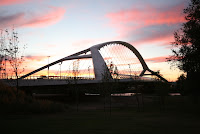

Planning a travel itinerary involves a compromise between time and desire. We of course want to see so much while travelling, but do realise we have to temper that goal with what is achievable in the time available. Rick Steves' travel guides have been most valuable, but they are paced uncomfortably fast so that travellers following them must see the world pass in a blur. At the other extreme, I am far too impatient to spend my holidays lying on a lounge next to a pool.
Don't we love lists? Well, if not you, at least I do. Lists are always fun to arrange and prioritise some thoughts. And this year we are learning much about travelling. So, with our limited, but growing experience, here are our top ten European car travel tips. Some are not original, but we have adopted them and taken as our own.


1. Take twice as much money as you thought you'd need. Travelling is expensive!! Car travel is cheaper than public with more than two persons. I tell myself to over-ride usual reluctance to spend and just enjoy these once-in-a-lifetime experiences, even if it is costly. Just do it.
2. Carry half as much stuff. Reduce and rewear. Wash out what you have whenever you have a chance.
3. When in small towns, eat as the locals do. Spanish restaurants start serving dinner after 9.30 p.m. The French and Germans? - 8 pm. In Britain, trying to get something to eat after 7.30 means you will go hungry. Some Switzerland places close by 7.00 p.m. I think I am seeing a pattern that the hotter the climate, the later the dinner time.


4. Rest your head on fewer pillows. Cut down on the packing/unpacking and time spent getting acquainted with a new place. Make a base from which to take side trips. We think that 3 days was about right in many places to see the major sights.
5. Enjoy what is near your place. Avoid travel to far-off towns, and consider well if it is worth the trip. Our biggest mistake was to take a side trip to travel all the way from Tours to Bourges to see its famous cathedral, only to find something we could have seen back in Tours. And, to make matters worse, we ran out of time to see the cathedral of Tours anyway. The grass did not look greener that day after hours driving on a hot road.


6. Beware of trying to make transport connections that are tightly scheduled. This will guarantee to increase the stress levels when you are worrying if you will arrive on time. The travel times predicted by ViaMichellin or Google Maps consistently underestimate the actual driving time. Their estimations may be calculated by travelling at the maximum speed limits. Well, skimming along at 130 km/hr is quite a scary experience, especially on winding mountain roads. Then there are the slow trucks, caravans, wheelchairs (yes, we crawled behind a man on a wheelchair for a few km) and traffic jams that mean that getting to the next city for lunch is simply impossible. Add in a lunch and toilet break, and a supposedly 3 hour trip turns into 4½ all too easily.
7. Carry toilet paper in France. Not much fun to find out too late - twice! Enough said.
8. Don't expect the women in the group to be ready early. Mission impossible. Allow two hours to depart.


9. Try and buy local foods. Buying baguettes and fillers such as cheese and salami is much cheaper than packaged rolls. Anne also has a small steel thermos which has saved a fortune in hot drinks.

10. Lastly, if someone asks, "Can you tell me what is the best thing to do when travelling to Switzerland on a budget?", the answer is, "Don't go!". Yes, tongue-in-cheek, but we had a wonderful time there in the Lautebrunnen valley. The views are stunning - and free!
To get into the spirit of each country, we play local music on the ipod while driving. Whether it's a stereotypical accordion playing in France, or oompah in Germany, it is all fun and rather charming.
Italy: Dean Martin singing Volare or That's Amore (I can't believe I was playing my dad's music!) and Andrea Bocelli's opera.

Germany: Bouncing along to the catchy Chicken Dance Polka, 1000km Bis Zum Meer by Luxuslärm, and Nena's catchy 99 Luftballoons.
In Bayeux we listened to Bonnie Tyler's Lost in France and Edith Piaf's soulful songs.
Spain: Freddie Mercury belting out Barcelona is hard to beat, and Sarah Brightman and friend singing Amigo Para Sempre adds some spice.
So, this travelling is enlightening and we are slowly learning how to do it better.






















































